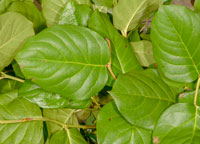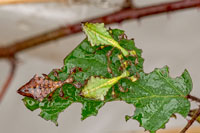Food plants
When the Free-Standing-Setup (FSS) is applied, then almost all Phyllium species accept bramble (Rubus spp.) easily. And obviously Phyllium thrive on bramble very well. The only exception (so far) was Phyllium bioculatum "Sukabumi", where freshly hatched nymphs would only accept Salal (Gaultheria shallon). Even though older nymphs and adults of this species finally did accept bramble very well too.

But feeding Phyllium on bramble can pose a problem during springtime, at least for breeders who live in an area with a climate similar to the one here in Switzerland. In spring (especially after a very cold winter), bramble leaves are often in a shabby condition. They might be blackish ("freezer burn"), withered up and sometimes covered with mould. No wonder that in late winter or spring it happens that Phyllium do not feed well or even flat out refuse to feed on these "old", last year's bramble leaves. The (chemical) composition of such old bramble leaves is changing, as the plant is reabsorbing ingredients from the leaves. Thus such leaves must taste differently and are surely of low(er) nutritional value. And thus Phyllium do no more "like" such leaves, and refuse to eat these. Further more Phyllium (as many other phasmids too) usually do not feed on the very fresh, new bramble leaves in spring. Thus it can be rather tricky, if not impossible to feed Phyllium on bramble during this time of the year. Even though bramble is a very good food plant throughout the rest of the year.
To avoid this situation, we are now feeding Phyllium cultures which hatch in late summer, autumn or winter exclusively with Salal (Gaultheria shallon). The quality of Salal is much more consistent during the year. And even though we get this from the florist shop, it is poison-free and safe to use. With Salal it is easy to feed Phyllium during winter. In late spring / early summer when the new bramble leaves are ripe again, then I offer again bramble to all my Phyllium cultures. The drawback is that one has to buy Salal which can be a bit costly - especially when one is breeding quite a number of different Phyllium cultures.
But why do we start to feed our Phyllium already with Salal, when there is still bramble around in the forests - like in autumn or early winter? The thing is, that it is easier to change the diet of a Phyllium culture from Salal to bramble than viceversa. It can be that they refuse to feed on Salal if they have first fed on bramble.

So far we experienced that the freshly hatched nymphs of only one Phyllium culture refused to feed on Salal, namely Phyllium letiranti "Tataba". So Salal is a very good and valuable food plant alternative (as it is for many other phasmid groups too).
If hatchlings refuse to feed on Salal, then try out these plants:
- Bramble (Rubus spp.)
- Strawberry leaves (Fragaria vesca) - partially wintergreen
- Raspberry (Rubus ideaeus) - only summergreen
- Wild rose (Rosa canina) - summergreen
- Guava (Psidium guajava)
- Oak (Quercus spp., summer- and wintergreen species)
Humidity
- A humidity of about 65 - 70 % RH (within the cage!) is good enough for Phyllium nymphs to moult and grow up with ease
- Contrary to a widespread misconception, Phyllium nymphs do not need an exeptionally high humidity to moult successfully. It is assumed that Phyllium are mainly treetop dwellers, and up there it is windy and the humidity is not as high as in other parts of the tropical rain forest
- During winter time (when the room heating is on), then humidity can drop to 50% RH or even below. Even though we found that most Phyllium nymphs moult successfully even at such a "low" humidity, still we take measures to increase the humidity within the cage to about 65%. This can be done by substantially reducing the ventilation area of the (netting) cage. For example by wrapping clear plastic foil around the (netting) cage, and (if need be) by keeping wet paper towel on the cage floor
- Even though Phyllium nymphs do quite well at a moderate humidity level, providing them with a high humidity is OK too. Just contrary to popular hearsay, a very high humidity is not absolutely necessary
- We found that adult males Phyllium do better if kept in a cage with an increased humidity, e.g. 80+ % RH. That is why we keep the adults at a higher humidity than the nymphs
Spraying water
Another often heard misconception is that one should not spray Phyllium (nymphs or adults) with water directly. The simple reason why this can't be true is that this phasmid group would have gone extinct a long time ago if they were so sensitive against water. Phyllium often rest during the day close or directly on the leaf margin. Thus they are exposed to rain, and it is raining rather often in their natural habitat. We are spraying all Phyllium directly (nymphs, adults and the food plants they are sitting on), and they are wet all over afterwards. Actually they like this.

- But do not use chlorinated water as spraying water. Such water is potentially dangerous for phasmids and harmful for us humans too
- Do not spray too often, the water must dry up before one is spraying again
- And even better to give them some "dry" periods as well, just spray them 2 - 3 times a week
- if you keep your Phyllium in a cage with reduced ventilation areas with wet paper towel on the cage floor, then reduce the spraying intervals to about once a week. A high humidity and spraying, that becomes quickly too much
-
We use a black-water conditioner (Dennerle TR7 Tropic or Tetra ToruMin) in the spraying water (about 50 drops per liter). Such "black water" conditioner contain plant extracts and are sold in pet shops (for fish keeping). It seems that these conditioners help in getting freshly hatched nymphs to start feeding. Maybe it adds some flavor which they like?